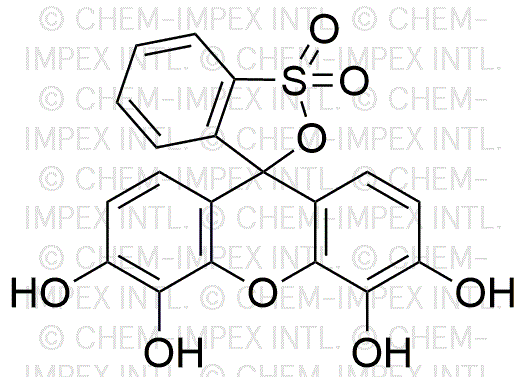Pyrogallol Red is widely utilized in research focused on:
- Biochemical Assays: This compound serves as a pH indicator in various biochemical assays, allowing researchers to monitor changes in acidity or alkalinity during reactions.
- Histology and Cytology: It is commonly used as a staining agent in histology, helping to visualize cellular structures in tissue samples, which is crucial for diagnosis and research.
- Textile Industry: Pyrogallol Red is employed as a dye in the textile industry, providing vibrant colors to fabrics while being more environmentally friendly compared to some synthetic dyes.
- Food Industry: This compound can be used as a food colorant, offering a natural alternative for enhancing the visual appeal of food products without harmful additives.
- Analytical Chemistry: It plays a role in analytical methods for detecting metal ions, making it valuable in environmental monitoring and quality control in various industries.
General Information
Properties
Safety and Regulations
Applications
Pyrogallol Red is widely utilized in research focused on:
- Biochemical Assays: This compound serves as a pH indicator in various biochemical assays, allowing researchers to monitor changes in acidity or alkalinity during reactions.
- Histology and Cytology: It is commonly used as a staining agent in histology, helping to visualize cellular structures in tissue samples, which is crucial for diagnosis and research.
- Textile Industry: Pyrogallol Red is employed as a dye in the textile industry, providing vibrant colors to fabrics while being more environmentally friendly compared to some synthetic dyes.
- Food Industry: This compound can be used as a food colorant, offering a natural alternative for enhancing the visual appeal of food products without harmful additives.
- Analytical Chemistry: It plays a role in analytical methods for detecting metal ions, making it valuable in environmental monitoring and quality control in various industries.
Documents
Safety Data Sheets (SDS)
The SDS provides comprehensive safety information on handling, storage, and disposal of the product.
Product Specification (PS)
The PS provides a comprehensive breakdown of the product’s properties, including chemical composition, physical state, purity, and storage requirements. It also details acceptable quality ranges and the product's intended applications.
Certificates of Analysis (COA)
Search for Certificates of Analysis (COA) by entering the products Lot Number. Lot and Batch Numbers can be found on a product’s label following the words ‘Lot’ or ‘Batch’.
*Catalog Number
*Lot Number
Certificates Of Origin (COO)
This COO confirms the country where the product was manufactured, and also details the materials and components used in it and whether it is derived from natural, synthetic, or other specific sources. This certificate may be required for customs, trade, and regulatory compliance.
*Catalog Number
*Lot Number
Safety Data Sheets (SDS)
The SDS provides comprehensive safety information on handling, storage, and disposal of the product.
DownloadProduct Specification (PS)
The PS provides a comprehensive breakdown of the product’s properties, including chemical composition, physical state, purity, and storage requirements. It also details acceptable quality ranges and the product's intended applications.
DownloadCertificates of Analysis (COA)
Search for Certificates of Analysis (COA) by entering the products Lot Number. Lot and Batch Numbers can be found on a product’s label following the words ‘Lot’ or ‘Batch’.
*Catalog Number
*Lot Number
Certificates Of Origin (COO)
This COO confirms the country where the product was manufactured, and also details the materials and components used in it and whether it is derived from natural, synthetic, or other specific sources. This certificate may be required for customs, trade, and regulatory compliance.


